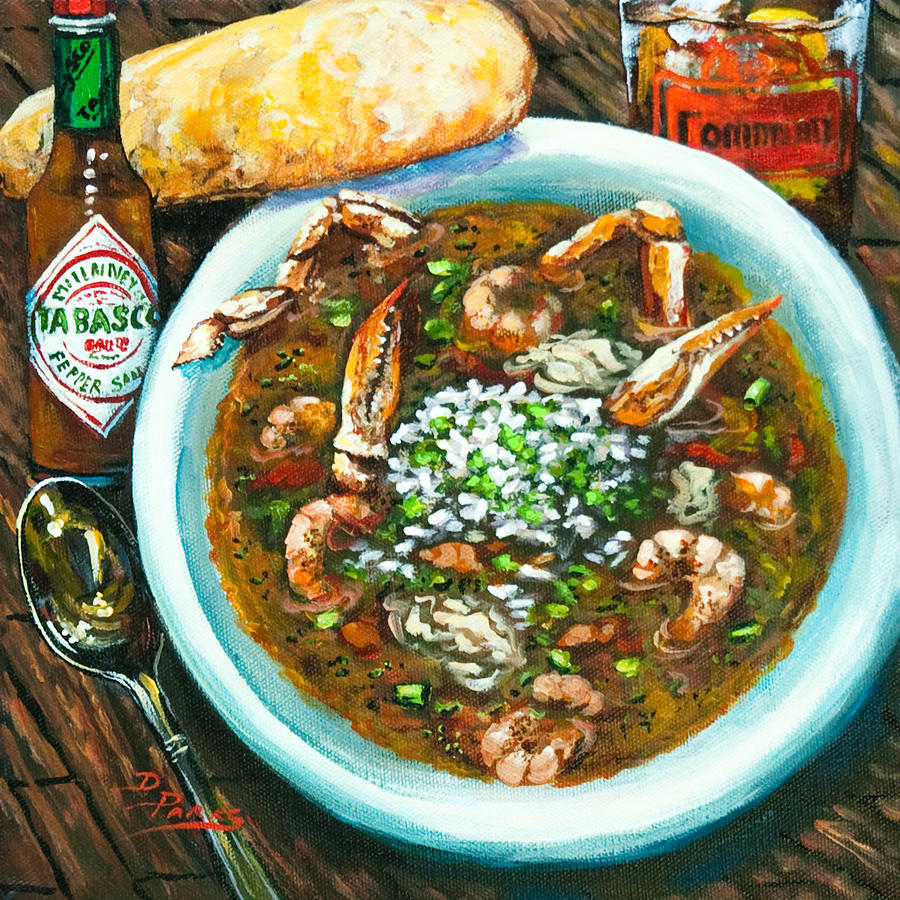Finding fresh okra at the grocery store or farmers’ market can start a party in the mouth – a party with visions of fine Creole cooking dancing in your head. Or maybe you’re a lucky gardener with plenty of okra to share with family and friends. Grow it or buy it, okra and the prospect of building an authentic, richly flavored Louisiana gumbo will always stimulate an urge to let the good times roll, even out in public.
Just as the author of the Creole Cookery Book (published in 1885) suggested that gumbo conjuring is an “occult science,” I too believe there’s something voodoo-ish (i.e. magical) about a well-made stew of gumbo.
Okra started it all. Thought to be of African origin, and still growing wild in the upper Nile valley, okra can be dealt with in many ways – stewed, fried, baked, what have you – but the dish called gumbo flat belongs to Louisiana cooking and is a creation of an ethnic conglomerate.
You could say that gumbo was invented by committee.
A potpourri of culinary traditions, the flour-and-fat roux that begins a great gumbo comes from the French; dried and ground sassafras leaves that make filé powder have origin in Native American cooking; Spanish, Creole, Caribbean and Cajun influences have stuck their spoons into the pot. And when the iniquity of slavery brought Africans to North America, the people brought with them not only their unique cooking methods, but many unknown foods, such as yams, black-eyed peas, watermelon and our friend, okra.
There are three different schools of thought about the best way to thicken a gumbo. The sticky substance that’s released from cooked okra is a thickener; additionally, the purpose of the roux is to add luxurious texture; and sprinkling filé into the stew at the end of cooking is also a thickening technique.
I use all three.
Among gumbo debaters the discussion often turns to how dark the roux should be.
My advice is to use your nose and your eyes. Pour in the vegetable oil, add an equal amount of flour and start stirring. It will take about 15 minutes for the roux to turn a caramel color. Lots of nouveau gumbo-makers get scared at this point, fearing they might burn the essential foundation. But be brave, venture on. Thirty minutes into it, and your base should resemble the color of a chocolate Labrador retriever.
Many years ago I wrote a haiku about gumbo roux. Using the brief Japanese poetry form to offer a tip about achieving perfection, the haiku says this:
If it looks like mud
It might be mud or gumbo
Trust the nose, which knows
I’m all for throwing the basic vegetables – onions, green peppers, celery – straight into the roux rather than sautéing in a separate pan. Once tossed in and mixed up with the roux, add broth and beer, maybe a splash or two of wine.
I do use a separate skillet to pre-cook the meats I plan to use in the gumbo. Chunks of chicken and pieces of venison sausage are my two favorite non-seafood choices. Throw the cooked meat in with the stewing vegetables about an hour before you add the seafood. My advice: Don’t be tempted to add the okra yet.
Persistent in the on-going gumbo debate is the controversy about tomatoes. Some people swear by tomatoes, and others think using them is as out of place as putting beans in chili. I put beans in chili, and I use tomatoes in gumbo.
Open a big can of peeled tomatoes and use your hands to squash each tomato into the soup. Stir it up and keep simmering. Or skip the tomato step and stay with the simmer. A couple of real pluses about gumbo: The measurements never need to be exact, and ingredients are a matter of personal choice.
Want to pitch in some alligator meat? Go for it, and let the fur fly.
When to add the chopped okra really depends on the cook’s preference. Some add okra early; this makes for a thicker soup, but you will see the okra turn from lime color to ogre green. Others put the okra in with the seafood, allowing the cooking time for okra to be limited to around eight minutes. This method doesn’t thicken the liquid as much as the extended cooking time, but the okra will not get mushy and it will retain a neon hue.
Sprinkling the pot with filé comes last. That’s the only rule in this otherwise rule-less recipe. Stir in those powdered sassafras leaves with the seafood at the very end of cooking – and be sure to set both the jar of filé and a bottle of Tabasco on the table when the gumbo is served.
DO DO THAT VOODOO GUMBO
1/2 cup each flour and extra virgin olive oil
1 1/2 cups each onions, green peppers, celery and red peppers, chopped
3 cloves garlic, smashed
1 jalapeño, chopped
2 bay leaves, crumpled
1 tsp. powdered thyme
1 Tbsp. each dried parsley, dried oregano and dried tarragon
salt and pepper to taste
2 cups chicken broth
1 bottle dark beer (Shiner bock is a good one)
3/4 cup red wine
1 1/2 cups chicken chunks, cooked
1 pound sausage (use andouille, venison or any spicy sausage; slice thinly or break into pieces), cooked
1 large can peeled tomatoes (optional)
1 1/2 cups okra, chopped
1 small package frozen crawfish
1 lb. raw shrimp, peeled and de-veined
1/2 cup raw oysters (optional)
1/4 cup filé
cooked rice
METHOD: In a high-sided large pot, heat the olive oil and begin adding flour. Using a whisk, stir over medium heat. When all flour is added, whisk constantly until the color of the roux approaches saddle brown. (If you burn it, please start over.)
When the roux is right, add the onions, peppers, celery, garlic, bay leaves, thyme, parsley, oregano, tarragon, salt and pepper. Stir and cook over low heat a few minutes.
Add the broth, beer and wine. Stir and let cook together about 10 or 15 minutes. Then add the chicken and sausage. Stir and cook about 5 minutes. Squeeze the tomatoes (if using) between the palms of your hands over the pot and add. Stir together and let cook about 35 to 45 minutes.
Add the okra at this point. Stir the okra into the gumbo, then add the crawfish, shrimp, oysters (if using) and the filé, and cook about 8 minutes, or until shrimp turn pink. In individual bowls, ladle the gumbo over cooked rice and serve. Serves 6 to 8.









Follow Us